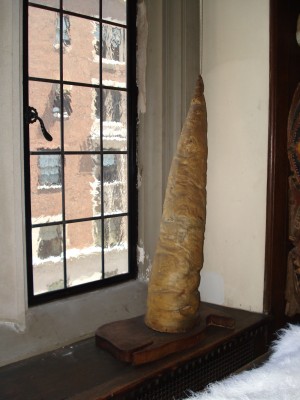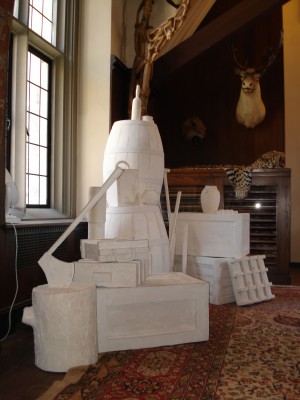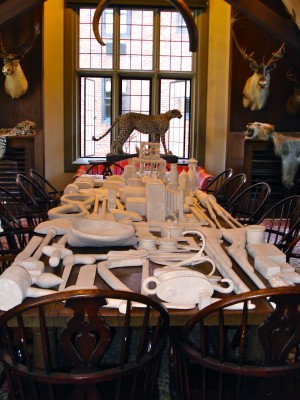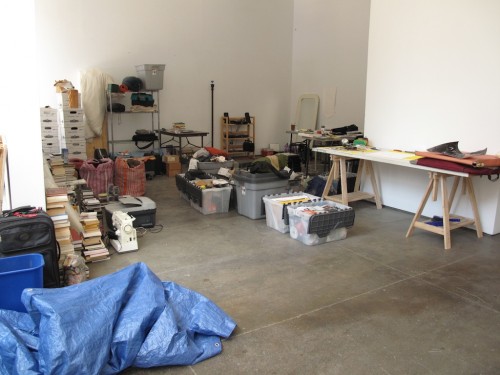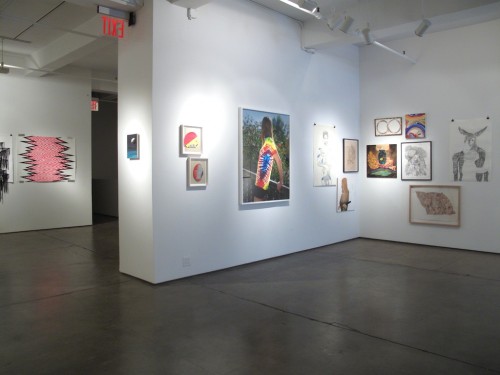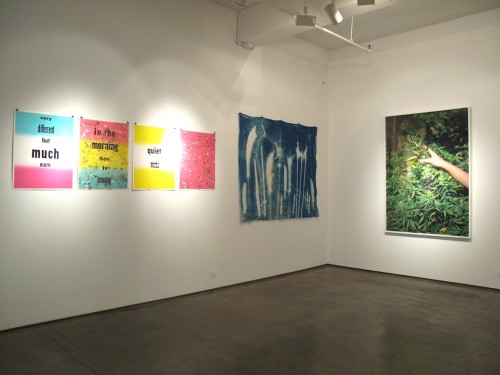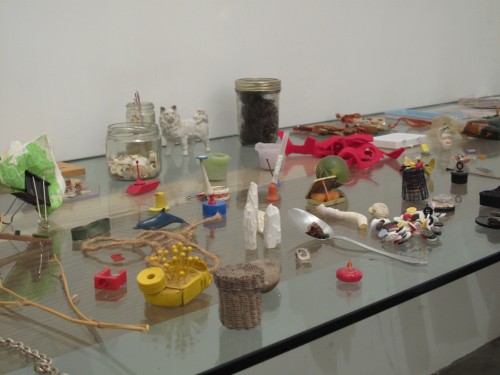THIS WEEK IN New York is your last chance to see two exhibits which seem separated by uptown and down, east and west – even a century, but both get at exploration and money, art and life. They’re meditations on living, home and things – things in particular and what gives an object power. In one the artist achieves this with a small intervention in a fancy Upper East Side townhouse; in the other an artist squats in a fancy Chelsea gallery.
Uptown on 70th between Park and Madison is a gothic revival townhouse that once belonged to Stephen Clark, heir to the Singer Sewing Machine fortune and whose father built the Dakota. Decked out with timbers and gables and hand-painted stained glass looted (perhaps) from medieval England, the home is adorned with many stuffed dead things. Those stuffed dead things are not Clark’s doing; they belong to the Explorers Club, the home’s current occupant. On the ground floor a yellowing polar bear stands on its hind legs, captured (or, at least, taxidermied) in some mode of attack.
The floors don’t simply have numbers like 2, 3, 4 and 5, but also come in halves including 5½ and 4½, lending a kookiness to the Explorers Club that wouldn’t be out of place in a Wes Anderson movie, not to mention the 7½ floor where Being John Malkovich took place. The hallway outside floor 5.5 is both sweltering – the air conditioning does not reach this far up – and bedecked with B&W photos in black frames hung salon style in a tight grid. Most are men, most in suits, most with hair brushed back and Brylcreemed into the crisp look of men of business and import. Few have names I recognize. There’s Walter Cronkite and Thor Heyerdahl. All are the club’s presidents and prizewinners. Down a flight on another landing is a portrait of another former president, Carl Akeley, “the father of modern taxidermy.” Not only a club president, he commissioned spooky paintings by William Leigh, also on landings in the building. Somewhere between impressionism and film sets, the paintings were models destined for dioramas at the Museum of Natural History. Akeley was also a pioneer of the diorama, and these facts of his life make him seem readymade for a Wes Anderson biopic – whenever he’s ready to take on a biopic, that is.
On floor 4½ is the Flag Room, an old ballroom displaying flags once stuck triumphantly in the ground on trips to space and the “real” (those quotes mine because the very notion of reality seems so weird here) North Pole, not to mention the banner Thor Heyerdahl carried with him on the Kon-Tiki expedition in his handmade raft. The flag-room-slash-ballroom is bedecked with a stone mantle assembled from pieces of medieval monasteries, and down a half set of stairs in the library, the ceiling comes from a monastic prayer room.
At the top of the building, the Trophy Room was once a gallery bedecked with paintings by Seuret and Van Gogh, Degas and Cezanne. Instead it now has a sperm whale’s penis (a big gray cone) and more stuffed dead things: leopards and lion skins, mounted heads, antlers and antelopes and giant racks of horns. In the middle a long oak table is strewn with papier-mâché guns and boots, lights and ropes, axes, anchors, a large-format camera, not to mention jugs, grinders and birdcages – all rendered a ghostly white as if mocking everything else in the room and building. In the corner stands a stack of white barrels and an axe and traps. It’s as if the ghost implements are the explanation for how all the dead stuffed things made it here in in the first place.
These papier-mâché tools are an installation by Mark Dion, one of my favorite artists. He’s interested in science and exploration, taxonomy and natural history and what those subjects say about us and our values. At the same time he finds a poetry in objects that gives them a kind of yearning power. Before the Tate Modern opened, he staked out the ground in front on the Thames, which flows on its north side just past the original Tate Britain, and downriver a mile away past Tate Modern on the south bank. Here, in front of both museums each day he’d collect whatever washed up at low tide. He found everything from bones to plastic dolls, shoes, buttons, nails and tools and created a kind of urban archeology with them, organizing them by type in a large mahogany cabinet. It has a quasi-scientific feel, plus it’s just cool looking. If you go to London, see it. He tries to pin down (and the attempt at pinning itself is moving) the limits of learning and science and that very human desire to categorize things.
But what is most moving here in the Explorers Club in Stephen Clark’s former townhouse are not the objects. Yes, they are made out of papier-mâché and have a ghostly look, still what the objects point up just by being here is the space itself and the story behind it. That is the power of art. It doesn’t have to adhere to empirical rules but can jump around connecting ideas in a boisterous way that hints at one thing while speaking to another.
The objects themselves are replicas of things taken on an exploration of remote China near the Tibetan Plateau. There 103 years ago Sterling Clark (Stephen’s brother) set out to put his proverbial stake in the ground and follow the dictates for late Victorian and Edwardian men of means to explore and conquer. Remade in papier-mâché, the tools make that journey of Clark’s look like hubris. But, science and exploration are always set in a historical moment, and in the townhouse, on the table is laid out an interesting question about science, philosophy, exploration, collecting and the limits of the known universe. Heck, the limits of knowledge and just what someone might do to conquer it. That’s a lot of weight for tools made of paper, wheat flour and water.
At the time of his expedition, Clark had already served in China as part of a multi-national force (how current that sounds) during the Boxer Rebellion, a war I know little to nothing about. It makes me wonder what people will think about Iraq or Afghanistan in a hundred and some years, if those conflicts will be just some vague names emptied of meaning by time?
During his voyage Clark sent back hundreds of specimens to the Smithsonian and British Museum and then had to leave abruptly. One of his men was killed by local villagers. A skirmish ensued; the details are vague, and the Chinese, Americans and British all insisted Clark’s expedition vamoosh. You can nearly imagine something like this happening today in Afghanistan. The team left most of its equipment behind. Who would carry out stuff that weighed thousands of pounds and took nearly 50 mules and donkeys to lug around? It’s a bit like the things left on Everest each year, only now we supposedly know better. This is why Dion recreated the equipment in papier-mâché. The things are the ghosts of items a group like Clark’s would have brought. Most moving of all though is a single gun, a Colt .45 set apart from the other items in a glass case with “trophies” in the Trophy Room, that is, with pillaged tools and African carvings. The revolver is a stand-in for the gun of the man who was shot – the gun he’d not taken with him when he left camp and was killed.
Who knows how these events affected Clark. Afterwards he took off for Paris where he went from collecting specimens to art. Later, he had plans with his brothers to set up a museum in Cooperstown where the family was based. To this day the Clarks maintain a hospital there as well as having endowed The Baseball Hall of Fame. In a huff, Sterling Clark pulled out of the planned fraternal art museum and instead established the Sterling and Francine Clark Institute in Williamstown. That’s the museum that put on this show.
So to summarize: we have an exhibit about a trip in the house that’s now the Explorers Club. The trip is about exploring, while the house used to be the brother’s – and the brothers had a fraught relationship. Stephen stayed home and managed the family’s money, and Sterling set out to explore and spend that money. Meanwhile, the exhibit was set up by the museum one brother established while dissing his other brothers, and the items of that exhibit are made in papier-mâché. They are all ghosts of tools that would be used in the hunting, killing and trapping of the stuffed dead things in the room where the tools and stuffed dead things are both exhibited, a room that once served as dissed brother’s art gallery. That’s a lot of doubling.
You need to know the story for it all to make sense. To that end the Clark Institute has hired a docent, a recent Williams grad. Sweet and smart in shorts and deck shoes, he guides us through the building and to the mantle pieces Sterling exhorted his brother to buy. It’s thanks to Dion’s objects that we get to see this space and through them to question its context. It also helps to have the docent explain the context. Dion’s use of things to point up questions about collecting and riches, home and exploring is what’s most powerful here. He doesn’t offer answers but gives us an excuse to poke through the building. Rarely open to the public, it’s a treat to peer into the members-only rooms where a guard is asleep in a chair. Somehow that too is moving and gets another sort of doubling downtown.
~
Downtown on West 20th Street at the far end of a block full of fancy art galleries, the plate glass windows of one are blacked out with spray paint. There’s a poster propped in a window and a notice on the door. It’s almost forbidding, like a speakeasy of an art gallery, and inside wafts the faint aroma of pot. This is where artist Dawn Kasper is living. For the Biennial she moved her life and studio into the museum, though they wouldn’t let her stay at night. When the museum closed, she decamped to a tiny rented room, but by moving her apartment/studio wholesale into the museum she turned the very nature of art and art making, the entire process from thinking and doodling and listening to music into performance, into art itself. It links her to artists like Marina Abramovic and Vito Acconci with their durational performances, Acconci settling in under the floor of the Sonnabend Gallery and masturbating and Abramavoic just sitting, sitting and staring and confronting visitors. There is nothing quite that disturbing about Kasper, which isn’t to say it’s of less value. Somehow it seems like art very much of this moment. This idea of life as art and art life fits the world today – if not the money wielding art world today, then certainly the recession-bound realm in which most of us live and work.
Kasper is here literally in the gallery on 20th Street because she was homeless after the Biennial, and one of its curators suggested to tony art dealer David Zwirner that he lend her the space. He’d rented it for storage while he was redoing the building next door. (Somehow that kind of boggles me, renting a huge premium Chelsea gallery space just for the storage. Then again the space itself boggles me. Leather sheaths are stitched around the handrails going down to the basement galleries. Leather. Wristbands. On the railings. As if touching the metal itself is too intimate, too cold, too visceral. Maybe that is why the gallery that had been here went out of business, leather railings…)
In the front room sit Kasper’s sewing machine and inkjet printer and piles and piles of things. There are records and tapes (yes, tapes) and DVDs (yes, DVDs) and the books (yes, books) as if this were an installation of outdated media. But, these are the things of her life, and living with them she makes her work, and the studio and life are all of a piece.
She also set up an exhibit of work by her friends. There are photos of pot plants and a girl in tie-dye; knit pieces by Liz Collins with florescent pink lightning bolts and tapestries of eyes that look like surreal psychedelic macramé; masks on sticks; intricate drawings morphing people and animals; and a giant installation in the basement of scatter art that made me feel like it was 1992 all over again. There’s no checklist, no wall-labels, no way to know what is what or who is who, and somehow everything becomes of equal value, or else comes to seem an extension of Kasper herself, though she has said she wanted to take the focus off her. I like the idea of someone being given a Chelsea gallery for a month and then opening it up to all, like when your parents went away for the weekend and you had a giant house party. So far the cops haven’t been called, but the place has a punk energy – and that odor of cannabis.
Kasper is easygoing and approachable. She bounces on the balls of her feet and has her hair cut in the floppy style of someone in a new wave band. She wears white Nike high-tops and cutoff pedal pushers. I ask if she ever gets tired of talking to people. “No,” she says, “it’s fun.” Or something like fun. I can’t imagine. One stack of books towering from the floor includes everything from lesbian poet and former presidential-candidate-as-performance-artist Eileen Myles to fire-and-brimstone-spouting Puritan Jonathan Edwards. Kasper and I talk about Edwards, who fascinates me for his own kind of taxonomy of nature. He wasn’t all Sinners In the Hands Of An Angry God, but wrote about the woods and flowers, making them a link to the divine. It’s proto-Emerson, and his writing gives each thing a ravishing power in and of itself.
Here in the gallery Kasper’s stuff means more than just things, a bit like the details from nature Edwards observed. They are her things, yes, but by being in the gallery more than that too. So, they are both at once, simultaneously mundane and art. She and Dion share this ability for things to represent both, having a greater power and still seeming humble. His papier-mâché tools are frail objects, stand-ins and symbols of something bigger. His show may have taken up a tiny fraction of the space, still he transformed how we see the entire building and the Explorers Club. So too with Kasper and the art gallery itself, her being here let’s us rethink the entirety of an art gallery.
Take the array of dimmer switches in a back room and a glass desk covered with stuff: buttons, a toy soldier and what looks like drug paraphernalia re-imagined as a hoarder’s assemblage. One of the pieces Kasper made here, it let’s us question the whole experience of what’s usually hidden behind closed doors in a gallery. It’s as if this ghost of a space, this shuttered gallery, has been remade in papier-mâché with the white switches on the walls and the white walls themselves (not to mention the bizarre leather laden handrails to the basement). Later, in one of David Zwirner’s four linked galleries on 19th Street, Zwirner himself stands on the polished cement floors. Dressed in jeans and a pale blue t-shirt, he looks both less and more than I expected. He’s talking to an assistant about a sale, and I slide past quickly, embarrassed to intrude on what should be (in my mind) a private conversation. I wish I’d been brazen enough to listen in. After seeing Kasper’s show, it seems important. Googling him later that afternoon, the image that came up on his Wikipedia page was Donald Trump. It had been hacked, and that too seems to be part of the exhibit.
Kasper’s work is the sum of its parts – and more than that. This is the month of the Higgs boson, the particle that gives everything weight and mass, and I promised you science and exploration in her work too. She’s using the show as a metaphor, adopting the idea of the multiverse and its parallel universes, with the physicist Alan Guth as her guiding light. His inflationary physics looks at the big bang and posits many, many big bangs (themselves using a Higgs field to work). Kasper sees the show as “the result of the collisions that may occur in our ever-expanding universe.” I just keep calling the show “Dawn Kasper’s Cosmos” because it feels like she’s wrapped her world and friends around her, appropriating them all. Her actual title for the show is “Fuel for the Fire.” For her it is about the people that you collect around you, which in these straightened times seems like a good strategy. Collectives and collectivity are interesting. It’s one of the things I like about The Weeklings.
Her things though are already ghosts. She writes in an email, “Since being in a museum they are no longer mine. They’re almost an illusion. Their sentimentality has been deconstructed. I still have attachments to said objects, but they are now part of a body of work, almost an archive.”
Our stuff is attached to memories and how we see ourselves, but by making art of her things, she has translated them too. In that process they are distanced and heightened. They mean both more and less than they did originally. She brings into question life and home, and as she bounces on her heels and we talk, I tell her about the Dion show at the Explorers Club. I try to explain the similarities and am sure make no sense. She writes down the address and promises she will go. Despite the similarities in the ideas behind the shows, one difference stands out. You can’t touch the pieces at the Explorers Club, and here in Zwirner’s Temporary Space you can. I joke about wanting to pitch up and reread the Edwards. She says, go for it. Only I don’t. I can’t. I’m a little too nervous – and it’s not just about touching art in a gallery. These are her things, after all, and that makes them still private. It’s no wonder that at 3 am on her first night here she spraypainted the windows. Everyone could see in and she needed the privacy.

